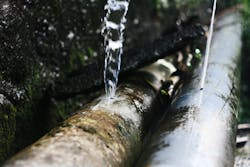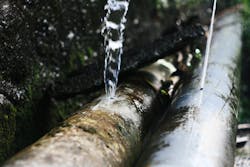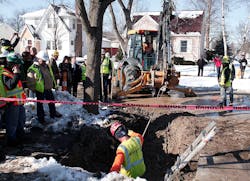CHICAGO — One trillion dollars over the next 25 years. That’s the price tag — the conservative price tag — of what it will take to fix America’s crumbling water infrastructure, according to the American Water Works Association.
Simply put, the nation’s investment in its water infrastructure has been insufficient for decades and time has begun to take its toll. The 2017 Infrastructure Report Card from the American Society of Civil Engineers paints a grim picture. The overall grade for the country’s water infrastructure? D.
Just to focus on the supply side, drinking water is delivered via approximately one million miles of pipes. Most of those pipes were laid in the early to mid-20th century with a lifespan of 75 to 100 years. Many major cities, particularly on the east coast, have water mains that were put in place in the second half of the nineteenth century. While the overall quality of drinking water in the U.S. remains high, legacy problems and emerging contaminants continue to require close attention. There are an estimated 240,000 water main breaks per year wasting over two trillion gallons of treated drinking water.
There are some reasons to be optimistic about the future. The recent prolonged drought in the Southwestern states, combined with the water crisis in Flint, Michigan, has raised awareness in the general public about a vital part of our nation’s infrastructure that normally goes unnoticed. Water quality and conservation are now a part of the national conversation in a way they haven’t been since the establishment of the EPA in 1970.
Underfunding of our vital drinking water and wastewater infrastructure is an issue we cannot ignore,— Ben Cardin
And there is movement at the federal level. Infrastructure was a hot topic for both major-party presidential candidates on the 2016 campaign trail (although the focus in stump speeches was mainly on transportation). Now, infrastructure appears to be an issue targeted by a Trump administration looking for a legislative “win.” There is even a bi-partisan bill moving through the Senate with a focus on water infrastructure systems.
But there are plenty of reasons to be pessimistic as well. There may not be enough money, there may not be enough skilled workers, and most importantly there may not be the political will to address the situation before reaching a crisis point. And that crisis will certainly imperil the health and well-being of a large number of Americans, particularly those on the lower end of the income ladder.
What about the rate-payer?
Grundfos, one of the world’s leading pump manufacturers, as part of its Who Runs the Water that Runs America initiative, recently conducted a survey of 2,000 Americans about their attitudes to their local water services. The survey was conducted between March 6-13, 2017, and the sample distribution mirrors that of the U.S. population based on Census data. (The full survey report, as well as 16 state-specific survey findings may be downloaded at http://us.grundfos.com/whorunsthewater/download-report.html.)
Some results of the survey include:
- 63 percent are worried about their access to clean water, with a higher percentage in the Northeast (66) and the West (69).
- Just 51 percent of Americans feel their water consumption is average; however, 33 percent of those 18-24 feel their consumption is above average, while only 5 percent of those 55+ feel their consumption is above average.
- Water supply and sewage systems are listed as the third most important infrastructure priority (after schools/educational institutions and hospitals/healthcare).
- Only 2 percent think they should pay more for water services.
It is that last item that’s the sticking point. The majority of funding for drinking water infrastructure comes from revenue generated by rate-payers, and they already feel like they’re paying enough for the services they receive. In the nation’s largest 50 cities, the rate users pay varies greatly, with the lowest monthly water bill averaging $14.74 in Memphis, and the highest in Seattle averaging $61.43.
“Improving our nation’s wastewater systems and ensuring that Americans have access to clean water is something we can all get behind,— John Boozeman
In fact, between 2009 and 2014, state and local governments decreased capital spending for both drinking water and wastewater by 22 percent; at the same time, federal capital spending did not change significantly.
The state and federal governments perform a complicated dance via the Drinking Water State Revolving Fund to deliver financial support to local governments and utilities in the form of low-interest loans for water infrastructure projects. The Environmental Protection Agency provides an allotment to the Revolving Fund for each state, and each state provides a 20 percent match. Since the program’s inception, $32.5 billion of low-interest loans have been allocated. However, needs are far surpassing the fund’s budget.
Utility managers are in many cases caught in a Catch-22. In areas with falling populations (and 99 out of 674 mid-sized cities in the U.S. are shrinking, according to the G.A.O.) fewer rate-payers and a declining tax base make it difficult to raise money for infrastructure investments. Since declining populations usually go hand-in-hand with declining economies, that means raising rates on the very people who can least afford it. Conversely, in areas that are booming such as the West and Southwest, managers have to scramble to keep up with increased demand.
Is there a plan?
In March, U.S. Transportation Secretary Elaine Chao said the Trump administration would unveil a $1 trillion infrastructure plan later this year, but she did not offer details of funding for projects.
Chao said at an event at the department's headquarters that the infrastructure initiative would include "a strategic, targeted program of investment valued at $1 trillion over 10 years. The proposal will cover more than transportation infrastructure, it will include energy, water and potentially broadband and veterans hospitals as well."
While details are sketchy — and most have only been discussed in connection with investments in transportation — some likely aspects of any infrastructure investment plan include:
- A focus on public-private partnerships (a favorite of the G.O.P.).
- A streamlined permitting process; permits for large projects can sometimes take several years to come through, but the new process could allow permitting in one year or even less.
- A 90-day deadline to get started on work in order to receive full funding.
Additionally, in May U.S. Senators John Boozeman (R-Ark.) and Ben Cardin (D-Md.) introduced the “Clean, Safe, Reliable Water Infrastructure Act” (S. 1137). The bill is bipartisan omnibus legislation seeking to amend the Safe Drinking Water Act and the Federal Water Pollution Control Act to add provisions relating to drinking water and wastewater infrastructure, including the formal federal establishment of the EPA’s WaterSense program, which would extend the successful water efficiency product labeling program in perpetuity.
“Improving our nation’s wastewater systems and ensuring that Americans have access to clean water is something we can all get behind,” Boozeman said, “Especially when it is accomplished in a manner that promotes openness, competition and efficiency.”
“Underfunding of our vital drinking water and wastewater infrastructure is an issue we cannot ignore,” Cardin said. “Year after year, Sen. Boozman and I work together to combat America’s growing need for repairs to its aging drinking water and wastewater systems. We recognize the public health risk and economic jeopardy from a growing population placing greater demands on a water infrastructure system that is nearing the end of its useful life.”
Shooting ourselves in the foot?
Yet for all the political momentum behind infrastructure investment, other political initiatives seem to be working at cross-purposes.
Take the WaterSense program, for example. One of the reasons the “Clean, Safe, Reliable Water Infrastructure Act” enshrines the program via legislation is that it was actually slated to be cut from the EPA’s 2018 budget. Because the WaterSense program has never been congressionally authorized, it does not have its own budget line item and for the past 10 years it has been funded only at the discretion of the EPA Administrator.
The proposed elimination of the program seems to stem from the current drive in Washington to eliminate burdensome government regulation and red tape. It ignores the fact that WaterSense has been a resounding success, saving Americans 1.5 trillion gallons of water and $32.6 billion dollars in water and energy costs since its inception in 2006.
Another issue is the workforce paradox. According to some back-of-the-envelope calculations done by Bloomberg News (Sen, Conor; “Math Will Kill Trump’s Infrastructure Plan;” March 1, 2017), 100 billion dollars in infrastructure spending a year will require an additional 570,000 construction workers. That’s not counting support staff such as truck drivers, project managers, environmental specialists etc. etc.
Which at first blush sounds fantastic. Good, high-paying jobs are the main selling point for any infrastructure investment. But where are those skilled workers going to come from?
The president’s budget preview in March called for a cut in funding for Perkins career and technical education (CTE) programs and for federal job training programs. Under the plan, Perkins would receive $949.5 million — $166 million less than the annualized amount under the current continued funding legislation.
The budget also proposes to decrease funding for Workforce Innovation and Opportunity Act (WIOA) job training and employment services formula programs by 39 percent, or $1.3 billion. In addition the plan would also cut adult education states grants by about $95 million, to $485 million. (Source: Community College Daily)
And let’s not forget the elephant in the room: roughly 1.1 million of the nation’s construction workers are undocumented immigrants. Given the well-publicized stance of the Trump administration, any infrastructure legislation would almost certainly contain a provision barring their employment as a pre-condition of funding.
Of course, this is not the first time the federal government has had it’s right hand getting in the way of its left. Any push to get more money in the pipeline, to get more projects started, is better than the current status quo. And yes, that money, those opportunities will eventually make their way to the plumbing and piping contractors needed to do the actual work, and that can only be good for the marketplace.
But America and the American people are probably not going to see the best value for the money they spend. We can only hope it won’t take a crisis — that is to say, another crisis — before the various players get their act together.
About the Author
Steve Spaulding
Editor-in-Chief - CONTRACTOR
Steve Spaulding is Editor-in-Chief for CONTRACTOR Magazine. He has been with the magazine since 1996, and has contributed to Radiant Living, NATE Magazine, and other Endeavor Media properties.


